Java Reference
In-Depth Information
18
// number of stairs at the given (x, y) position
19
// with the given color
20
public static void
drawPyramid(Graphics g, Color c,
21
int
x,
int
y,
int
stairs) {
22
23
// draws the border rectangle
24
g.drawRect(x, y, SIZE, SIZE);
25
26
// draws the stairs of the pyramid
27
for
(
int
i = 0; i < stairs; i++) {
28
int
stairHeight = SIZE / stairs;
29
int
stairWidth = stairHeight * (i + 1);
30
int
stairX = x + (SIZE - stairWidth) / 2;
31
int
stairY = y + stairHeight * i;
32
33
// fills the rectangles with the fill colors
34
g.setColor(c);
35
g.fillRect(stairX, stairY, stairWidth, stairHeight);
36
37
// draws the black rectangle outlines
38
g.setColor(Color.BLACK);
39
g.drawRect(stairX, stairY, stairWidth, stairHeight);
40
}
41
}
42 }
Chapter Summary
DrawingPanel
is a custom class provided by the authors
to easily show a graphical window on the screen. A
DrawingPanel
contains a
Graphics
object that can be
used to draw lines, text, and shapes on the screen using
different colors.
The
Graphics
object can write text on the screen with its
drawString
method. You can specify different font styles
and sizes with the
setFont
method.
Graphical programs that are decomposed into methods
must pass appropriate parameters to those methods (for
example, the
Graphics
object, as well as any (
x
,
y
)
coordinates, sizes, or other values that guide the figures to
be drawn).
A
Graphics
object has many useful methods for drawing
shapes and lines, such as
drawLine
,
fillRect
, and
setColor
. Shapes can be “drawn” (drawing only the
outline) or “filled” (coloring the entire shape).




Search WWH ::

Custom Search